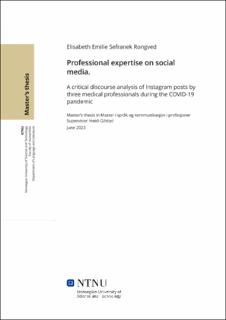| dc.contributor.advisor | Gilstad, Heidi | |
| dc.contributor.author | Rongved, Elisabeth Emilie Sefranek | |
| dc.date.accessioned | 2023-10-03T17:19:28Z | |
| dc.date.available | 2023-10-03T17:19:28Z | |
| dc.date.issued | 2023 | |
| dc.identifier | no.ntnu:inspera:145411398:51306177 | |
| dc.identifier.uri | https://hdl.handle.net/11250/3093876 | |
| dc.description.abstract | Denne masteroppgaven retter søkelyset på Instagram som arena for profesjonell kommunikasjon for medisinske fagpersoner under COVID-19-pandemien. Instagram under pandemien kan ses på som et eksempel på en «crucial communicative site at (a) critical moment» (Sarangi & Candlin, 2010, s.1).
Oppgaven er en kvalitativ casestudie av dokumenter. I oppgaven utforskes Instagram-innlegg skrevet av tre medisinske fagpersoner. Alle var på Instagram under fulle navn og profesjonelle titler, og de postet regelmessig innhold relatert til COVID-19-vaksinen.
Studien tar utgangspunkt i sosialkonstruktivistiske og interaksjonistiske perspektiver, og har en dialogisk tilnærming (Bakhtin, 2005) til språk og kommunikasjon. Det analytiske rammeverket er Gees kritiske diskursanalyse (Gee, 2011, 2014), understøttet av Myers (Myers, 2010) og Hylands (Hyland, 2005) bidrag til analyse av språklige markører i skriftlige tekster. Marwick og boyds beskrivelse av det “imaginære publikumet” (imagined audiences) (Marwick & boyd, 2010) for skrivere av digitale tekster, samt Linells perspektiver på kontekst (Linell, 2001) har også bidratt til analysen av Instagram-forfatternes interaksjoner med leserne.
Oppgaven tar sikte på å undersøke hvilke språklige og kommunikative virkemidler medisinske fagpersoner bruker for å uttrykke det de vet og tror når de kommuniserer om COVID-19-vaksinene på Instagram; hva de gjør kommunikativt ved å bruke disse virkemidlene; og hva dette sier om deres kommunikative kompetanse (Sarangi, 2018).
Analysen viser at medisinske og vitenskapelige Diskurser (Gee, 2014) er fremtredende i forfatternes kommunikasjon av medisin og vitenskap på Instagram. De posisjonerer seg som mer kunnskapsrike enn leseren, noe som kan minne om de tradisjonelle rollene i møter mellom lege og pasient. Analysen viser imidlertid også at de håndterer mulighetene og begrensningene på Instagram som medium, og at de deltar i det man kan kalle en «Instagram-Diskurs», noe som innebærer å delta i og bidra til den større Samtalen (Conversation) (Gee, 2014) om COVID-19 som foregikk på dette tidspunktet.
Resultatene indikerer derfor at kommunikativ ekspertise for medisinsk fagpersonell på Instagram ikke begrenser seg til å gi leseren tilgang til «vitenskapelig/teknisk kunnskap og klinisk/erfaringsmessig kunnskap» (Friedson, 1970 i Sarangi, 2010, s.171, min overs.) gjennom en kompetent håndtering av mediet. Snarere utvikler medisinske fagpersoner på Instagram sin kommunikative ekspertise i dialog med både sin tradisjonelle, farlige Diskurs og de nye, stadig foranderlige Diskursene på Instagram. | |
| dc.description.abstract | This thesis draws attention to Instagram as an arena for medical professional communication during the COVID-19 pandemic. Instagram during the pandemic can be described as a «crucial communicative site at (a) critical moment» (Sarangi & Candlin, 2010, p.1).
The thesis is a qualitive case study of documents. It explores Instagram posts written by three medical professionals who during the pandemic all had public Instagram accounts under their full name, displaying their status as medical professionals, and who regularly posted content related to the COVID-19 vaccine.
The study draws on social constructivist and interactionist perspectives and takes a dialogical approach (Bakhtin, 2005) to language and communication. The analytical framework is Gee’s critical discourse analysis (Gee, 2011, 2014), supported by Myers’ (Myers, 2010) and Hyland’s (Hyland, 2005) contributions to the analysis of linguistic markers in written texts. Marwick and boyd’s description of online writers’ “imagined audience” (Marwick & boyd, 2010) and Linell’s perspectives on contexts (Linell, 2001) have also contributed to the analysis of the writers’ interactions with their readers.
The thesis aims to investigate which linguistic and communicative features the medical professionals apply to express what they know and believe in their communication of the COVID-19 vaccines on Instagram; what they are doing communicatively by applying these features; and what this says about their communicative expertise (Sarangi, 2018).
The analysis shows that the medical professionals are privileging the Discourse (Gee, 2014) of medicine and science in their communication on Instagram. They are positioning themselves as more knowledgeable as the reader, similar to the traditional roles of doctors vs patients in the clinic. However, the analysis also shows that they are also expertly handling the affordances and limitations of Instagram as a medium, and participating in the Discourses of Instagram, which includes participating in and contributing to the larger Conversation (Gee, 2014) of COVID-19.
As such, the results indicate that communicative expertise for medical professionals on Instagram is not limited to giving the reader access to “scientific/technical knowledge and clinical/experiential knowledge” (Friedson, 1970 in Sarangi, 2010, p.171) through a competent handling of the medium. Rather, medical professionals on Instagram develop their communicative expertise in dialogue with both their traditional Discourse and the new, evolving Discourses on Instagram. | |
| dc.language | eng | |
| dc.publisher | NTNU | |
| dc.title | Professional expertise on social media. A critical discourse analysis of Instagram posts by three medical professionals during the COVID-19 pandemic. | |
| dc.type | Master thesis | |
